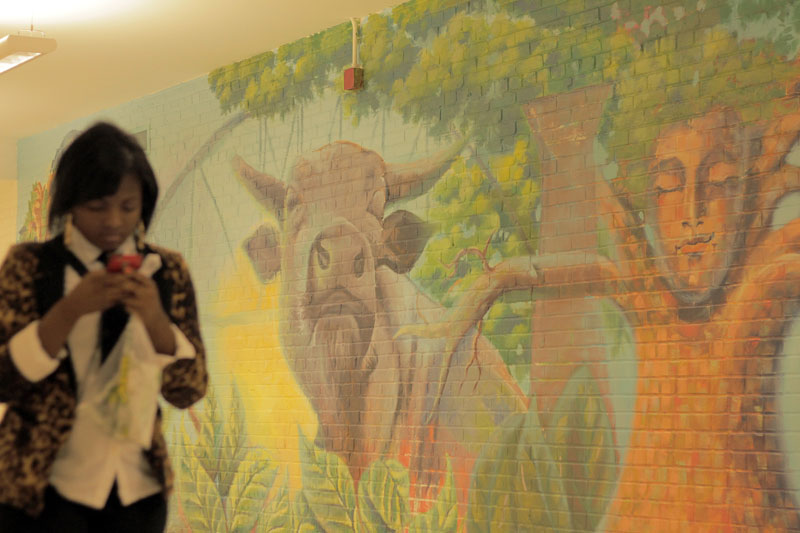
Two murals, painted by participants in the “ROOTS: Social Histories through Murals” project, decorate the halls in the Holton Resource Center.
Photo by Matt Phillips
The mural speaks to us of history.
The vibrant yellows, the hissing blues and the bull’s hard stare remind those who walk past it on the first floor of the Holton Resource Center: This, here, is the Bull City.
Tough as nails. Hard as bricks. But soft, too, like the carefully painted green leaves.
The mural, and another like it on the second floor, were painted as part of “ROOTS: Social Histories through Murals,” a project facilitated by the Durham nonprofit, Global Leadership Institute Inc.
LeAnne Disla, the institute’s executive director, said the project helps students analyze their communities. They conduct original research before developing a plan for the murals, which are painted by a group of Dominican muralists.
The students dig into the complex tapestry of local history. Their research leads them to images that represent their community. Responsible, critical analysis of important social constructs like race and economic oppression are part of the process. And that’s what makes the murals important, according to Disla.
“To do a piece of public art you need to know your community,” Disla said. “You need to know your history.”
The process starts with a group trip to the Dominican province of Hermanas Mirabal, where students and other community members attend a seven-day institute.
Hermanas Mirabal is the birthplace of MARHMI, the Movimiento Artistico Hermanas Mirabal, an artist collective led by muralist Hector Blanco that has painted over 400 murals in the province with the goal of reclaiming public space.
Students and community members tour the province and attend workshops. The experience is meant to help them understand how to let local history define the concepts of their own murals back home.
Disla said traveling to Hermanas Mirabal is critical because it makes participants aware of their own culture’s value. The province is named after the famed Las Hermanas Mirabal, four Dominican sisters who gave up lives of privilege to fight against the Trujillo dictatorship.
Disla said the story of the sisters, and travelling in the province, inspires students to ask themselves important questions like what they would erase in their own communities – if only they could.
“We don’t give them [students] nearly the credit we should,” Disla said. “I’m always amazed at what students come up with.”
Robert Hunter, who taught liberal arts in the Durham and Wake County school systems for over thirty years, is the arts education coordinator for the project. He said he thinks projects like this one are the future of global education.
“It really helps kids to open their eyes that they live in a vast community that’s rich in history,” Hunter said. “It’s a very motivating and stimulating approach to learning.”
But Hunter said the project is also about community ties. The process is such that people have to decide on the mural imagery together, but the dialog isn’t just about beautification.
“A community comes together to show who they are, and what they want people to know,” Hunter said. “It really teaches learning for passion’s sake.
Danielle Payton teaches French at Cedar Ridge High School in Hillsborough. She’s also an education consultant for Global Leadership Institute Inc.
Payton said projects like this one “turn learning on its head.
In a digital age when students are difficult to teach, and standardized testing is king, Payton said it’s important to engage students outside the classroom setting.
“With this you get the opportunity to get outside and interact with the people around you,” Payton said. “It’s a more interesting, more engaging Twenty First Century interaction.”
The Global Leadership Institute took over 30 students and community members to the Dominican Republic back in June. The cost for attending was $1,800, which covered lodging and flights. It also helped pay for the artist’s trip to the United States to paint murals.
Besides the two murals at Holton Resource Center “ROOTS: Social Histories through Murals” has completed mural projects at Josephine Dobbs Clement Early College High School, James E. Shepard Magnet Middle School and Hillside High School.
Payton said while the process may seem unfamiliar to some people it leads to a deeper education, and a more global outlook for students.
“It gives them [students] a feeling of empowerment because they are actually involved in their own education,” Payton said.
For more information, or to become involved with “ROOTS: Social Histories through Murals” email info@gleadershipinstitute.com or call 919-768-2836.
Global Leadership Institute — http://www.gleadershipinstitute.com/
Rafael Trujillo — http://www.biography.com/people/rafael-trujillo-39891